
Scout pointing
POINT-uhr 
The Pointer, also known as the English Pointer, is a powerful hunting dog. The head is about as wide as the muzzle is long. The neck is long. The muzzle is deep. The stop is well-defined. The nose is black or brown in color in the darker coated dogs and may be lighter or flesh-colored in the lighter dogs. The teeth should meet in a level or scissors bite. The round eyes are dark in contrast with the markings on the coat. The hanging ears are somewhat pointed at the end. The front legs are straight. The tail is larger at the root, tapering to a point. The coat is short, smooth and dense. Coat colors include primarily white with liver, lemon, black and/or orange markings, either patched or speckled, or can be solid in color. May be tricolored.
English Pointers are extremely high energy, and very enthusiastic hunters. With enough exercise they will be calm in the home. Intelligent, devoted, loyal and clean, they are patient, friendly, affectionate, love children and are a true friend to the family. They adapt well to new situations. Can be reserved with strangers. Socialize well at an early age and as the owner of the dog, be sure to stay mentally strong so the dog can feed from your energy to avoid timidity. Nervous humans tend to have nervous dogs because the dog can feel your emotions. If you do not provide enough mental and/or physical exercise they will become high-strung and distractible and can become neurotic and destructive. If they sense their owners are not as strong-minded as themselves they will become a bit willful as they will believe they need to be the leader of the relationship. It will bark at suspicious noises, but it is not a watchdog. Hunting instincts develop early. Puppies will start to display pointing behavior as young as 8 weeks old. These dogs are generally good with other pets and are not usually dog-aggressive.
Height: Males 22 - 24 inches (55 - 62 cm) Females 21 - 24 inches (54 - 60 cm)
Weight: 44 - 66 pounds (20 - 30 kg)
Prone to hip dysplasia, thyroid problems and dwarfism. Also skin conditions.
These dogs are not recommended for apartment life. They are moderately active indoors and do best with acreage.
This dog is extremely energetic and tireless. It is very important that it gets daily vigorous exercise to prevent extreme indoor restlessness. This breed is more than a match for even the most active family and should not be taken on as a family pet unless they can guarantee plenty of vigorous exercise. They need to be taken on a daily, brisk, long walk, jog or run alongside you when you bicycle. They are excellent jogging companions. Some love to swim and retrieve although they were not bred for that task. While out on the walk the dog must be made to heel beside or behind the person holding the lead, as instinct tells a dog the leader leads the way, and that leader needs to be the human. Teach them to enter and exit door and gateways after the humans. When the dog is taught to work as a hunting dog it must be taught the difference between when it is time to work and when it is not. When it is not time to hunt, the dog should be respectfully heeling on a leash for the handler.
About 13-14 years.
About 5-10 puppies
The smooth coat of the Pointer is very easy to groom. Just brush regularly with a firm bristle brush and bathe only when necessary. A rub with a piece of toweling or chamois will leave the coat gleaming. Check the feet also, especially after the dog has been exercising or working. Dry the dog thoroughly after hunting to prevent chilling. Ears should be checked regularly. This breed is an average shedder.
The first recorded mentions of the Pointer were in England around 1650. The Pointer was developed by crossing the Italian Pointer, Foxhound, Bloodhound, Greyhound, Newfoundland, Setter, and the Bulldog. The name derived from the way the dog stands motionless when he spots his game as if he is pointing right at it. Before hunting with guns was popular, Pointers were used to find hare for the Greyhound to hunt. By the early 1700s the Pointer became very popular among hunters. Excellent at catching a scent and pointing the hunter in the right direction, the dogs are very quick and can cover a lot of ground in a short amount of time and are often used to flush out birds. They are not water dogs nor are they expected to retrieve the kill. The dogs work great in warm weather but do not do well when it is very cold. The English Pointer often wins Pointing Field Trials over all other pointing breeds. The Pointer was first recognized by the AKC in 1884.
Gun Dog, AKC Sporting

An adult Pointer Dog—Photo courtesy of David Hancock
Pilot in the tub (winter time so it's dry)
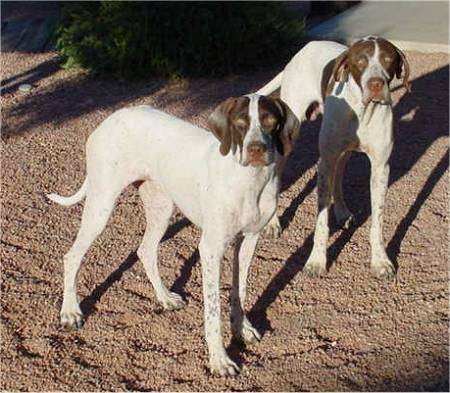
This is Pilot (right) and Scout (left). They are both 10 months old in this photo. Photo courtesy of the John family
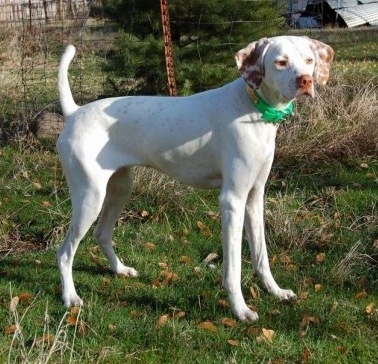
"This is Grendel, our Pointer. Her coloration is white with orange freckles. Grendel is just over 2 years old and is a complete joy. She is a working hunting dog, which helps to get rid of her energy. She's smart, but these dogs are stubborn and not incredibly easy to train. Their puppy stage lasts about 2 years and they are INSANE during that time, so unless you have 2 years during which you can devote multiple hours of time to training and exercise per day, this is not the dog breed for you. She is a very rewarding pet and a very sweet little couch potato when exercised consistently, but she will drive you nuts if you forget to take her out one day! If you are considering this breed, please keep in mind that they are bred to have the stamina to run long distances for hours and hours on hunting excursions, so unless you can provide either a hunting environment or something to replace it, it isn't really fair to the dog. She is way more likely to point butterflies in the park than play fetch with a tennis ball and in situations where she can run free, she will come and check in with you for a second, but spends most of her time hunting around for birds. She is very independent outside, but has been trained to come to a whistle very successfully. She is extremely tenacious and will run like mad in snow, through thick brush, on sand, and will swim in rivers and even the ocean. She runs so much that it is really difficult to keep weight on her, which I have heard is really common with pointing breeds. All in all, Grendel is an amazing dog. She is a hunting dog through and through who is also a pet. She is high-energy to a fault, but when properly exercised she is really sweet in the house, very cuddly. We love our Pointer!"
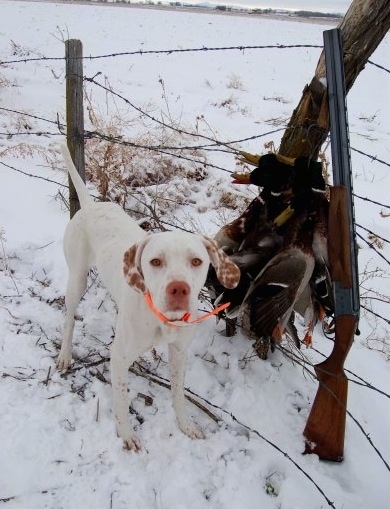
Grendel the Pointer after a day of hunting
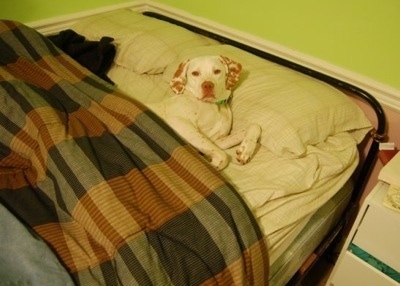
Grendel the Pointer taking a nap in the bed
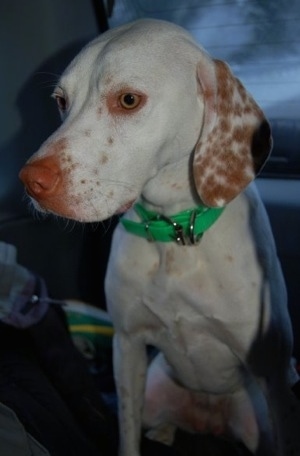
Grendel the Pointer at 2 years old—her coloring is white with orange freckles.